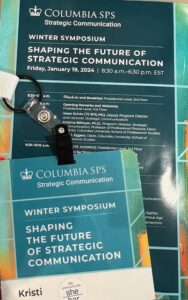An elementary school lesson influences a corporate communications approach
 My fifth-grade teacher once distributed a class assignment with the preface that if the entire class completed it successfully, she would throw us an ice cream party. Her caveat? We could not ask questions during the exercise.
My fifth-grade teacher once distributed a class assignment with the preface that if the entire class completed it successfully, she would throw us an ice cream party. Her caveat? We could not ask questions during the exercise.
The assignment outlined 25 simple actions to take – from the mildly distracting (tapping a pencil three times on our desks), to the downright bizarre (getting out of our seats and hopping on one leg for 30 seconds). The assignment seemed odd coming from our strict, well-respected teacher… but with a class party on the line, we eagerly accepted her challenge.
I recall stifling giggles while my fellow students attempted to balance erasers on their noses and barked like dogs. Throughout the process, our unfazed teacher quietly graded papers at her corner desk.
After the last student completed the assignment, our teacher finally looked up from her grading, slid her chair to the front of the room, and sat to face us.
“How many of you read the whole assignment?” she asked.
A dozen hands flew into the air.
“You did not,” she said matter-of-factly, looking over the top of her glasses at us.
We looked at each other quizzically. We had seen each other complete the tasks. Then we looked around the room. Who messed up? Who had cost us the party?
“The first line on the worksheet instructed you to read the entire page first,” she explained. “The last line said to disregard steps one through twenty-five, fold your hands, and sit quietly at your desk. None of you passed.”
Some students sighed at the trick, while others became indignant, demanding the party anyway. I was heartbroken, because I felt duped. I could almost taste that ice cream!
My teacher’s lesson resonated with me profoundly that day – especially since she threw us the party anyway. It’s relevant today because it taught me:
- Associates are often willing to take action if you have earned their trust, articulated the action’s benefit, and provided clear instructions. Do you want employees to register for training? Attend a meeting? Volunteer to lead a project? If they trust you, care about your common goal and can easily participate, most folks will take action – even if what you’re requesting is new or unexpected.
- Don’t bury key messages in text communication. Associates today are overwhelmed with communications, and most skip the fine print. Keep your messages clear and brief, and repeat critical information across multiple channels. If your audience misses it the first time, they’ll likely catch it the second time around.
- Use face-to-face channels to explain complex or emotional information. Save complex lessons or emotional conversations for face-to-face meetings. Without leader or manager follow-up, teasers, tricks or big business-changing news can break your audience’s trust and create tension down the road.
- Always give your audience the opportunity to ask questions. Eliminating two-way dialog results in audience hesitancy and frustration. It’s important to have a forum for questions, even if folks choose not to use it.
- “Informing” or “driving awareness” are not objectives. Our teacher could have told us we were careless readers, but we would have never believed her. Her communication objective was not to inform us about our carelessness, but to change our reading behavior. Strategically getting audiences to think, do or feel something differently goes beyond simply telling them something.
- Reward a lesson learned. Praise and recognition go a long way in reinforcing lessons. Relevant rewards (with a message) can communicate desired behavior changes.
This lesson was pre-internet and pre-email, but these tips are as relevant and timeless today as they were in 1984. I’m grateful for it, and wonder how many of my classmates apply it today.
With more than two decades of communications experience spanning agencies, Fortune-100 organizations, non-profits and academia, Kristi Hinck Mills today brings her passion for communications to CommsLede Consulting, where she delivers smart, targeted communications solutions for her clients – on time and within budget.



